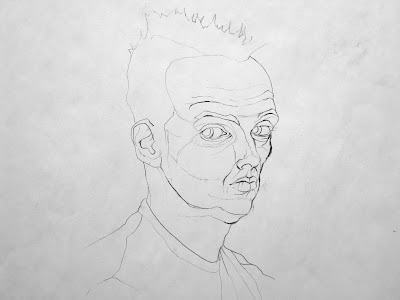What is Intercross?
Overview
Intercross is a drawing system that simplifies any object to be drawn to its essential form through a network of point relationships. Four initial points (a highest point, lowest point, furthest point left and furthest point right) are determined and set down on the paper. This forms a kite-like shape whereby the width of the entire object can now be compared to the height of the entire object to further confirm the placement of your initial 4 points. Additional points are added, each of which refer back to the initial 4. How do you know what additional points to add? Like a fractal, we want the drawing to develop from big to small - from the largest shapes to ever smaller ones that are contained within. It takes lots of practice but you will get the hang of it if you continue practicing. Intercross is the underlying armature of the drawing - not the drawing itself per-se. What you ultimately do with line contour line, value, color, etc. will make the drawing uniquely your own. Intercross will just get you spot on proportions.
Tips
· Some people may find this approach overwhelmingly analytical to start a drawing with. An easy solution is to start your drawing with a fast (15 seconds) and lightly drawn gesture drawing. Proceed by building your intercross upon that ghostly essence.
· Keep in mind you will be creating only small points and straight lines. You are roughing things in - you don't need a ruler. Be fussy about the exactitude of your measurements - not the cleanliness of your intercross.
Instruction
· Each object you are drawing has a highest point, a lowest point, a furthest point left and a furthest point right. Start by finding the two points that are farthest from each other (points 1 and 2 in the above diagram) and draw on your paper the angle of the line required to travel between those points. Hold up your pencil (or use a section of cord or twine) and use it as a tool to measure the angle of the actual object in real life. If the angle you see with your pencil does not match the angle you see on your paper make a correction.
· Next, seek out the furthest points left and right (points 3 and 4 above) and draw the angle you see between them. To assure your proportions on a whole are correct make sure the angle between all of the points match up. Therefore compare 4 to 1 and 3 to 2. Make changes wherever you need to to assure these four points are positioned correctly. When you know these points to be true you may block them in (the blue rectangle around each figure) to establish the boundaries of the playing field where the game of the drawing will take place.
· These first four points are the most obvious but we need many more to proceed. If we are drawing the human figure these additional points should initially include the shoulders, elbows, wrists, pelvis, knees, ankles, etc. Any area that is distinctive in structure or function should be included with more subtle points becoming evident as you proceed. Each point that is added should be cross referenced with other points both near and far with an angle drawn between them on your paper and measured in the air with your pencil.
· In this way the drawing proceeds from basic to complex - like a fractal unfolding before us. More and more points and angles are added until the magic moment happens – from a network of points and lines an image appears. You may find it helpful to make some angles darker than others. Notice in the above example that while all of the lines are important some define the three-dimensional structure more than others. If all of the points and lines are of the same darkness the technique will confuse you more than help you.
· Just as gesture has a particular lifespan in your drawing so to does intercross. It provides you with a blueprint for where the drawing goes next. At a certain point it seems to want to be wed with other techniques such as planar structure, negative space, value shapes, etc.
Right Hemisphere vs. Left Hemisphere
Like any helpful drawing strategy it requires the submission of the left hemisphere to the right hemisphere of the brain. With intercross we are asking ourselves to make unusual comparisons of which we have no previously stored symbolic knowledge. We have a symbol for "the foot" stored in our head but we don't have a symbol for "the angle between the pink toe and the highest point of the head." When we ask the left hemisphere to find such information it becomes frustrated and forfeits the task to the right hemisphere. Furthermore since symbols rely upon outlines we ban outlines in favor of drawing angles between points. In the end we get something very close to what would be considered an "outline" but it shows up merely as a side effect – not the goal – of the process.
Sources
The inventor of intercross is Robert Rivers at the University of Central Florida. There may be other very similar techniques with different names (I have heard of one described by Philip Guston when explaining his life drawing classes in school) and if you know of any please let me know. But by and large I have never run into this technique, by any other name, after reading various books on drawing. The inspiration for the neurological aspect of this technique is largely derived from Betty Edwards' book, Drawing on The Right Side Of The Brain.






%20-drawing_detail1494.jpg)
Comments